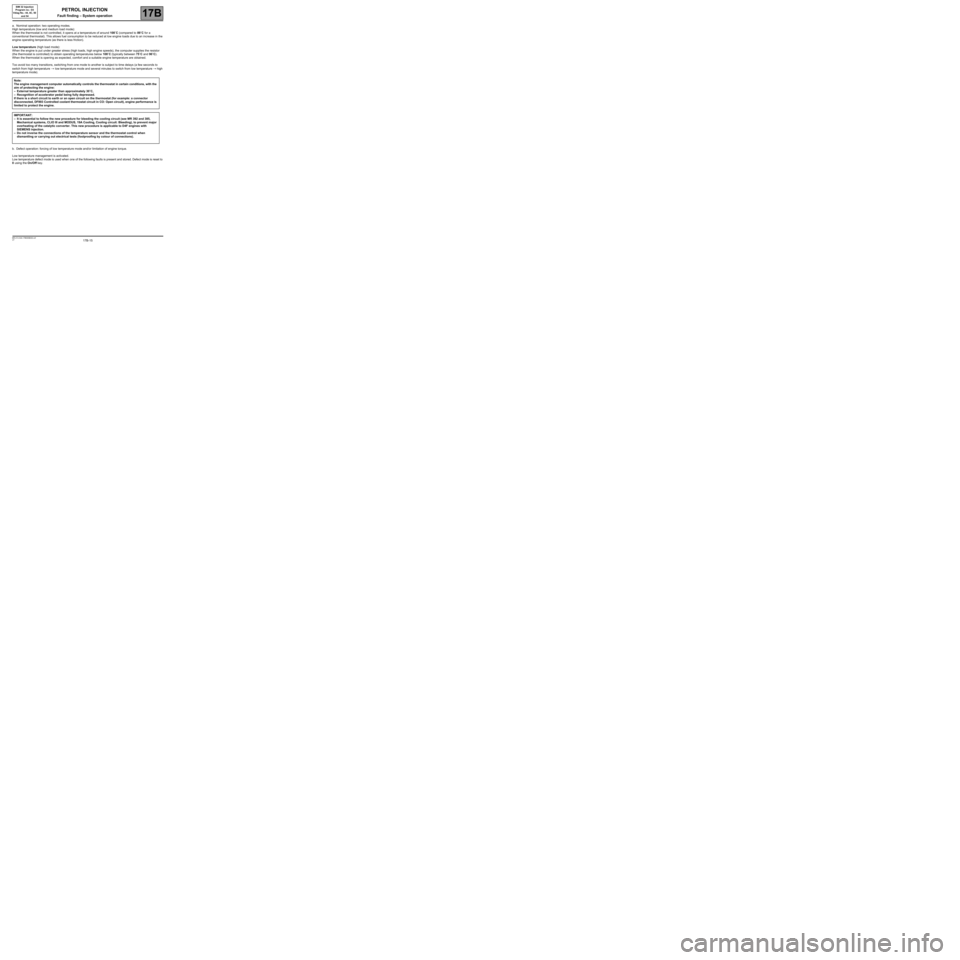Page 3 of 348

17B-3V7 MR-413-X44-17B000$010.mif
PETROL INJECTION
Fault finding – Introduction17B
SIM 32 Injection
Program no.: D3
Vdiag No.: 44, 4C, 50
and 54
3. REMINDERS
Procedure
For MODUS vehicles:
To run fault finding on the vehicle's computers, switch on the ignition in fault finding mode (+ after ignition feed).
For CLIO III vehicles:
To run fault finding on the vehicle computers, switch on the ignition.
Depending on the type of vehicle equipment, proceed as follows:
To cut off the + after ignition feed, proceed as follows:
For NEW TWINGO vehicles:
To run fault finding on the vehicle computers, switch on the ignition. Proceed as follows:
–turn the ignition key to APC,
–connect the diagnostic tool and perform the required operations.
To cut off the + after ignition feed, proceed as follows:
–disconnect the diagnostic tool,
–turn the ignition key to OFF,
–verify that the forced + after ignition feed has been switched off by checking that the computer warning lights on
the control panel have gone out. For vehicles with key/radiofrequency remote control unit,
switch on the ignition with the key.
For vehicles with a Renault card,
insert the vehicle card in the card reader.
press and hold the start button (longer than 5 seconds) with start-up conditions not fulfilled,
connect the diagnostic tool and perform the required operations.
For vehicles with key/radiofrequency remote control unit,
switch off the ignition with the key.
For vehicles with a Renault card,
press the Start button twice briefly (less than 3 seconds),
ensure that the + after ignition feed has been cut off by checking that the computer indicator lights on the instrument
panel have gone out.
Page 15 of 348

17B-15V7 MR-413-X44-17B000$030.mif
PETROL INJECTION
Fault finding – System operation17B
SIM 32 Injection
Program no.: D3
Vdiag No.: 44, 4C, 50
and 54
a. Nominal operation: two operating modes.
High temperature (low and medium load mode):
When the thermostat is not controlled, it opens at a temperature of around 108˚C (compared to 89˚C for a
conventional thermostat). This allows fuel consumption to be reduced at low engine loads due to an increase in the
engine operating temperature (as there is less friction).
Low temperature (high load mode):
When the engine is put under greater stress (high loads, high engine speeds), the computer supplies the resistor
(the thermostat is controlled) to obtain operating temperatures below 108˚C (typically between 75˚C and 90˚C).
When the thermostat is opening as expected, comfort and a suitable engine temperature are obtained.
Too avoid too many transitions, switching from one mode to another is subject to time delays (a few seconds to
switch from high temperature
→ low temperature mode and several minutes to switch from low temperature → high
temperature mode).
b. Defect operation: forcing of low temperature mode and/or limitation of engine torque.
Low temperature management is activated.
Low temperature defect mode is used when one of the following faults is present and stored. Defect mode is reset to
0 using the On/Off key. Note:
The engine management computer automatically controls the thermostat in certain conditions, with the
aim of protecting the engine:
–External temperature greater than approximately 30˚C,
–Recognition of accelerator pedal being fully depressed.
If there is a short circuit to earth or an open circuit on the thermostat (for example: a connector
disconnected, DF893 Controlled coolant thermostat circuit in CO: Open circuit), engine performance is
limited to protect the engine.
IMPORTANT:
–It is essential to follow the new procedure for bleeding the cooling circuit (see MR 392 and 385,
Mechanical systems, CLIO III and MODUS, 19A Cooling, Cooling circuit: Bleeding), to prevent major
overheating of the catalytic converter. This new procedure is applicable to D4F engines with
SIEMENS injection.
–Do not inverse the connections of the temperature sensor and the thermostat control when
dismantling or carrying out electrical tests (foolproofing by colour of connections).
Page 224 of 348

17B-224V7 MR-413-X44-17B000$152.mif
PETROL INJECTION
Fault finding – Interpretation of statuses17B
SIM 32 Injection
Program no.: D3
Vdiag No.: 44, 4C, 50
and 54
ET341IMMOBILISER CODE PROGRAMMED
STATUS
DEFINITIONYES: This status indicates that the immobiliser code has been programmed.
NO: This status indicates that the immobiliser code has not been programmed.
NOTESSpecial notes:
Perform these checks if the parameters correspond with the system operation
programming.
There must be no present or stored faults.
Conformity check with engine stopped and ignition on, or engine running, and engine coolant
temperature > 80˚C
"YES"Status ET341 is YES if dialogue is possible between the UCH computer and the
injection computer and the key code is recognised.
The engine is only authorised to start if the code is recognised by the UCH computer
and if status ET003 Immobiliser is INACTIVE.
In the event of a fault, (see 87B, Passenger compartment connection unit,
conformity check).
"NO"Status ET341 is NO if dialogue is not possible between the UCH computer and the
injection computer (status ET003 remains ACTIVE).
This fault may be caused by incorrect key programming or a lack of key programming.
In this case, refer to the UCH fault finding note (see 87B, Passenger compartment
connection unit) and follow the key programming procedure.
If the key programming is not the cause, run a multiplex network test (see 88B,
Multiplexing) and check that dialogue between the UCH and the injection
computer is possible.
If dialogue is not established, contact the Techline.
SIM32_V44_ET341/SIM32_V4C_ET341/SIM32_V50_ET341/SIM32_V54_ET341
AFTER REPAIRCarry out a road test followed by a check with the diagnostic tool.